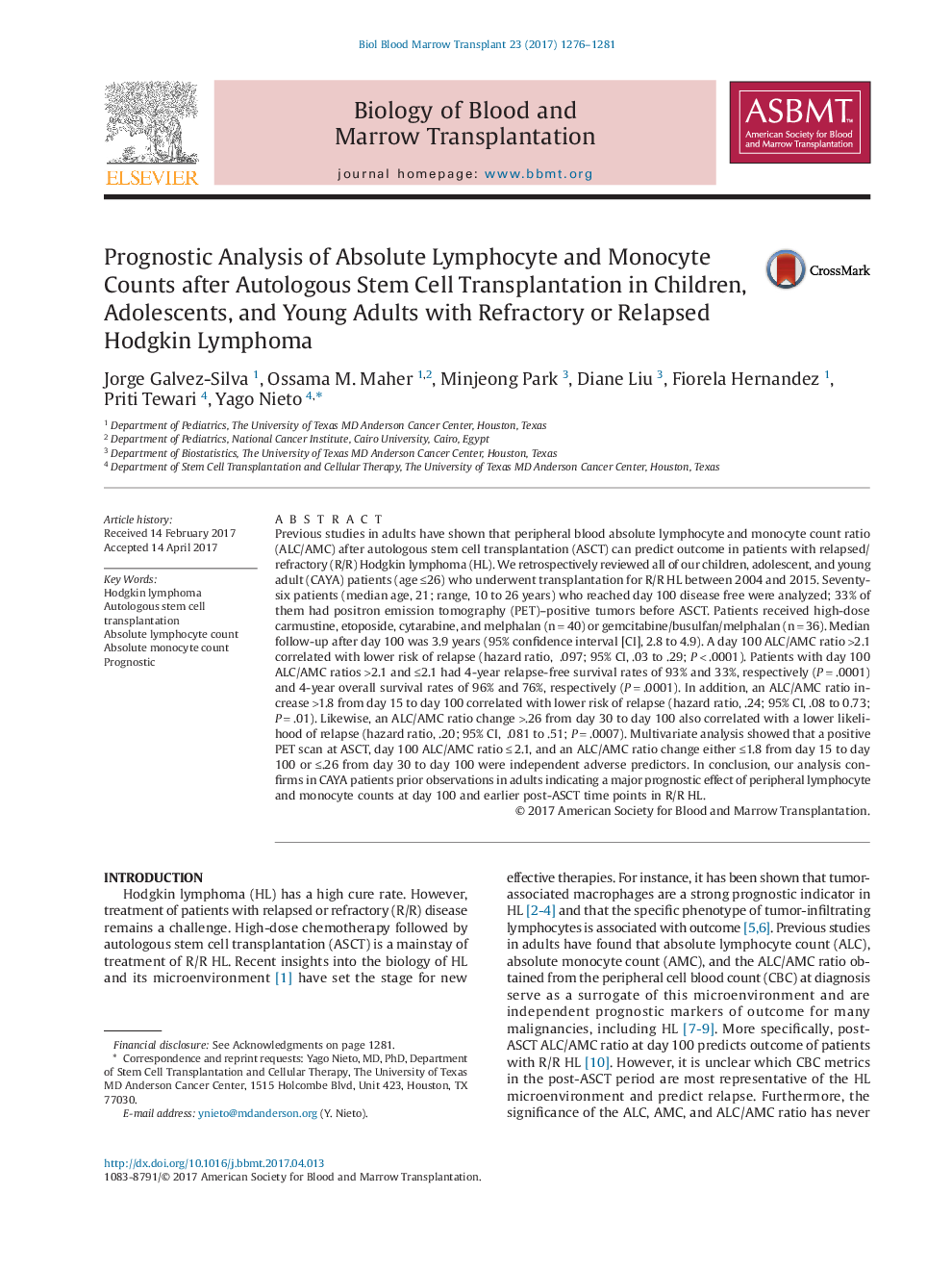| کد مقاله | کد نشریه | سال انتشار | مقاله انگلیسی | نسخه تمام متن |
|---|---|---|---|---|
| 5524111 | 1546238 | 2017 | 6 صفحه PDF | دانلود رایگان |
- Early post-autologous stem cell transplantation immune recovery has a major prognostic effect in children, adolescents, and young adults with Hodgkin lymphoma
- Higher absolute lymphocyte count/absolute monocyte count ratio on day 15 (and its increase to day 100) correlated with lower relapse risk
- Post-autologous stem cell transplantation absolute lymphocyte count/absolute monocyte count ratio and positron emission tomography status at autologous stem cell transplantation were independent outcome predictors
Previous studies in adults have shown that peripheral blood absolute lymphocyte and monocyte count ratio (ALC/AMC) after autologous stem cell transplantation (ASCT) can predict outcome in patients with relapsed/refractory (R/R) Hodgkin lymphoma (HL). We retrospectively reviewed all of our children, adolescent, and young adult (CAYA) patients (age â¤26) who underwent transplantation for R/R HL between 2004 and 2015. Seventy-six patients (median age, 21; range, 10 to 26 years) who reached day 100 disease free were analyzed; 33% of them had positron emission tomography (PET)-positive tumors before ASCT. Patients received high-dose carmustine, etoposide, cytarabine, and melphalan (nâ=â40) or gemcitabine/busulfan/melphalan (nâ=â36). Median follow-up after day 100 was 3.9 years (95% confidence interval [CI],â2.8 to 4.9). A day 100 ALC/AMC ratio >2.1 correlated with lower risk of relapse (hazard ratio, â.097; 95% CI,â.03 to .29; Pâ<.0001). Patients with day 100 ALC/AMC ratios >2.1 and â¤2.1 had 4-year relapse-free survival rates of 93% and 33%, respectively (Pâ=â.0001) and 4-year overall survival rates of 96% and 76%, respectively (Pâ=â.0001). In addition, an ALC/AMC ratio increase >1.8 from day 15 to day 100 correlated with lower risk of relapse (hazard ratio,â.24; 95% CI, .08 to 0.73; Pâ=â.01). Likewise, an ALC/AMC ratio change >.26 from day 30 to day 100 also correlated with a lower likelihood of relapse (hazard ratio, .20; 95% CI, â.081 to .51; Pâ=â.0007). Multivariate analysis showed that a positive PET scan at ASCT, day 100 ALC/AMC ratioââ¤â2.1, and an ALC/AMC ratio change either â¤1.8 from day 15 to day 100 or â¤.26 from day 30 to day 100 were independent adverse predictors. In conclusion, our analysis confirms in CAYA patients prior observations in adults indicating a major prognostic effect of peripheral lymphocyte and monocyte counts at day 100 and earlier post-ASCT time points in R/R HL.
Journal: Biology of Blood and Marrow Transplantation - Volume 23, Issue 8, August 2017, Pages 1276-1281
